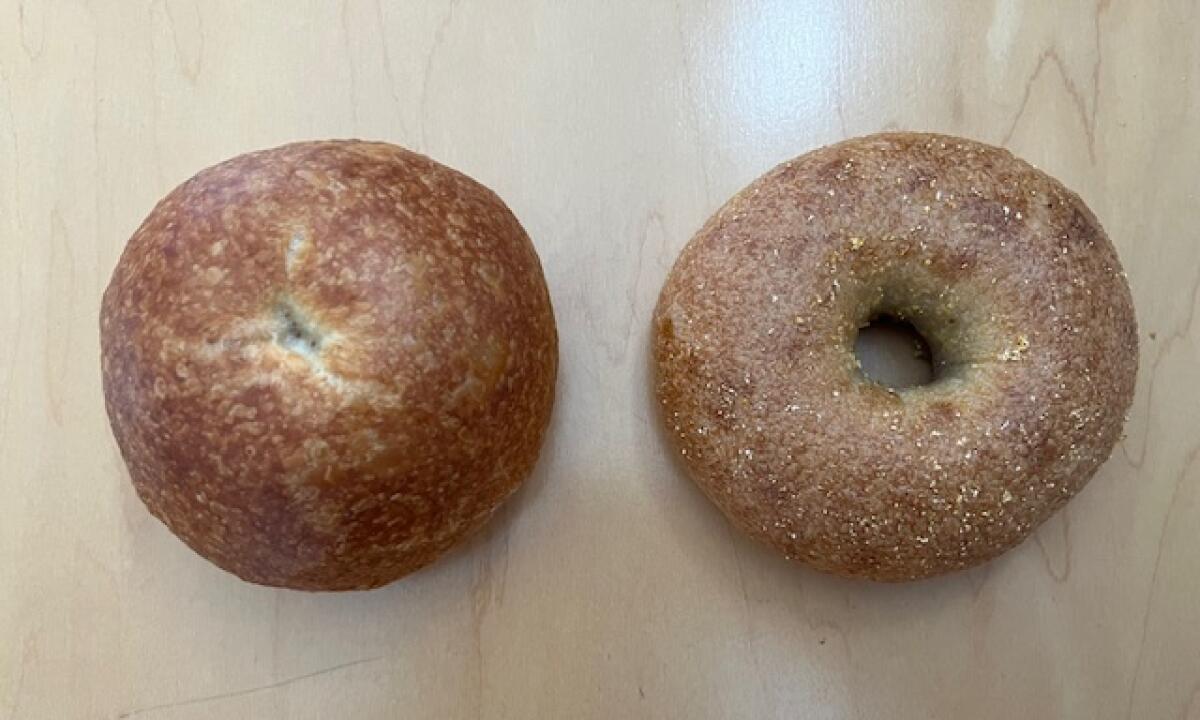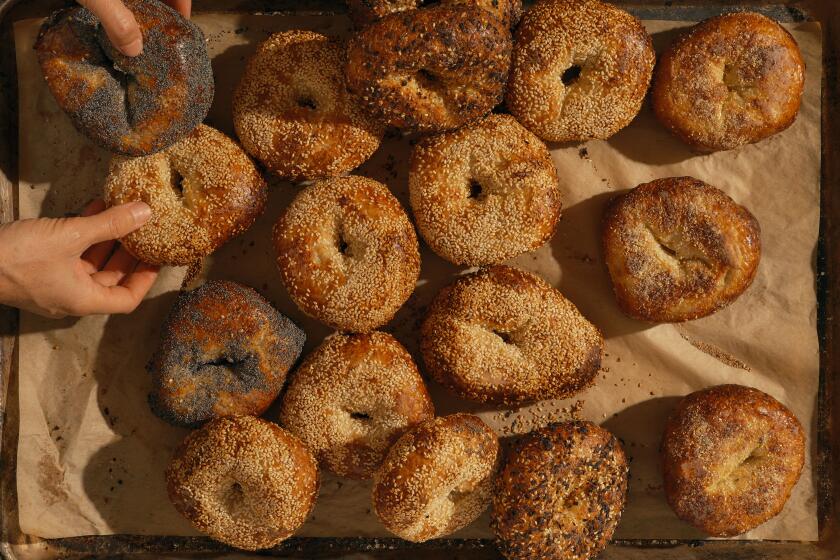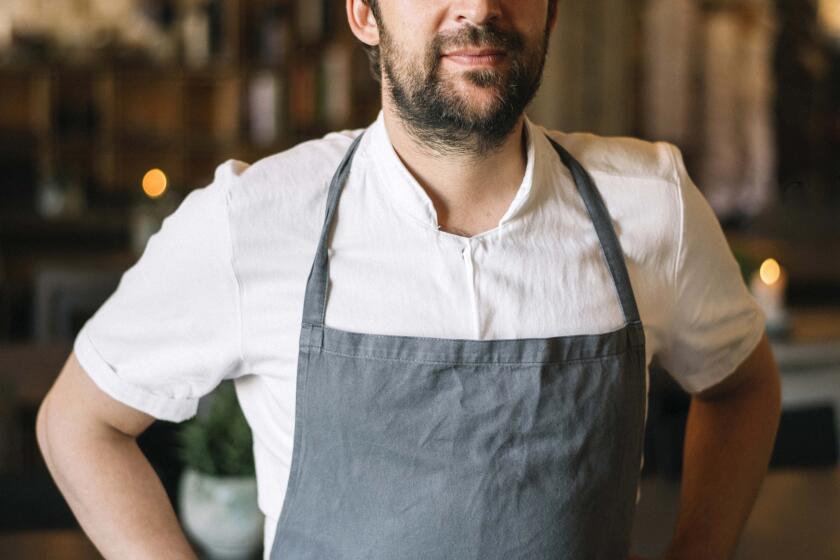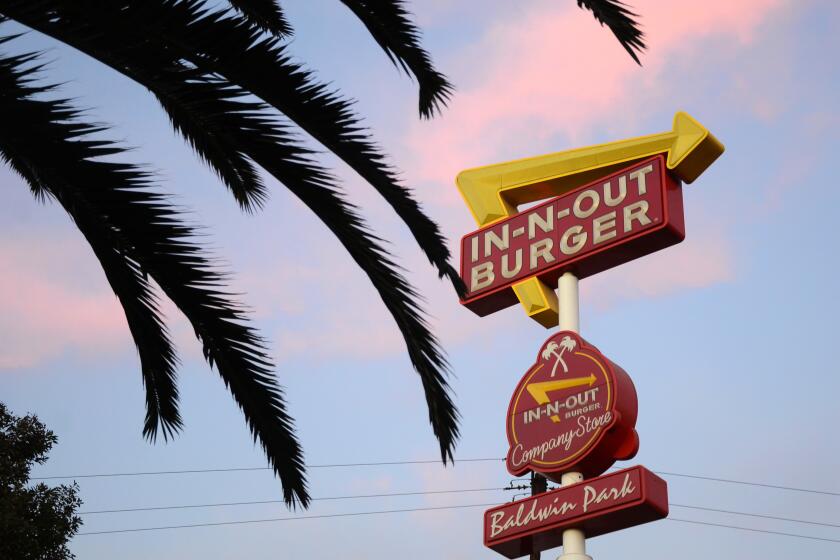Opinion: Just donât call it a bagel. Itâs fluffy, domed and dimpled

Bagels are under siege, and if you need proof, I offer a single word: Airy.
Bagels, which have always been synonymous with chewy, have recently been described â approvingly â as airy on both coasts and in Canada.
Also, fluffy.
And because they are, they risk losing another defining characteristic, along with the chew. Some of them â not all, but some â no longer have a hole in the center, which raises the existential question, when does a bagel cease to be a bagel and become another kind of bread?
From classic New York-style to more experimental bagel shops, hereâs where to get the best bagels in L.A.
Not yet, it seems, given the adulatory coverage of what could become the new normal.
Iâm staring at a fluffy specimen at a neighborhood bagel spot so popular that I drove by multiple times in search of a window when there werenât 20 people in line. Reasonable breakfast and brunch times were impossible, so one morning I showed up at the door five minutes after the place opened, when there were only three people ahead of me.
Finally, I considered my prize. It had a suspiciously domed profile, as opposed to the real thing, which more closely resembles a hockey puck. The apex of the dome bounced back when I pressed it, a yeasty little trampoline. Must be all that airiness trapped inside, I thought.
And trapped it was, because this bagel had no hole. It had a dimple, but I couldnât poke through the indentation to the other side. Canât twirl this kind of bagel on your finger, not that you would, but you should be able to, if it lived up to its name.
Fine dining establishments struggle to survive, and restaurants that lose a Michelin star struggle even more.
Donât get me wrong. My breakfast order was delicious; not only was it airy verging on lofty, it was sourdough, strongly so. Iâd gladly make a sandwich with it, maybe even deflate its loft into a bagel/panini hybrid. It could be croutons once itâs stale. Iâd buy it again.
But it is not a bagel. Squishy, hole-less â itâs the end of the world as we know it. And I do not feel fine.
I am not being nostalgic here. There are practical reasons for a bagelâs texture and hole. The dense structure holds up to toppings in a way softer, lighter bagels do not. And the hole means increased surface area, which means no soggy center and more crust per bite. Airiness messes with a bagelâs very DNA, and long-term, with its identity. Enough of these aerated products and we might start to think that a true bagel is not the real thing.
Over the last several years thereâs been an ongoing debate about culinary cultural appropriation, grounded in a history of white chefs commandeering ethnic cuisines, putting ethnic chefs at a disadvantage in what is already a wildly competitive profession. This isnât that; the bakers behind the new bagel are a diverse bunch, some with Eastern European roots, like the bagel itself, and others, not. They talk about the âLos Angeles bagel,â a proud mix of then and now, testimony to the cityâs cuisine without borders.
Californiaâs favorite fast-food chain hasnât changed its alignment with anti-vax and anti-LGBTQ politics. Thatâs not the point.
And while I keep a concerned eye on the trend, at least it is the product of creative innovation. The troubling cloud on the bagel horizon is cast by none other than Philadelphia Cream Cheese, the longtime other half of âbagel and schmear,â which has rolled out Philly Bagel Wholes in partnership with bagel bakers nationwide and in Canada â an equally dimpled if more puck-like item whose slogan is, âNow thereâs more room for Philly.â More surface area requires more cream cheese; the inspiration, here, is the bottom line.
Iâd like to suggest that serious bakers and bagel fans can have it all, preserve the old and celebrate the new. Eleven years ago, New York-based pastry chef Dominique Ansel announced the birth of the Cronut, a trademarked combination of the croissant and the doughnut that replaced neither; it was its own new entity. He wasnât muddying the waters, just paddling out further, to a unique pastry with a unique name.
We can do that too â agree that whatever that thing in front of me was, it wasnât a bagel, and market its distinct identity in a way that doesnât cancel out its heritage. In my family, we refer to inflated bagel variants as âa brioche in a bagel costume,â which seems a promising place to start. We can create a mashup. We can update the terminology.
Order a briogel with schmear. Ask for an everything bagoche. But leave the bagel alone.
Karen Stabinerâs most recent book is âGeneration Chef: Risking It All for a New American Dream.â
More to Read
A cure for the common opinion
Get thought-provoking perspectives with our weekly newsletter.
You may occasionally receive promotional content from the Los Angeles Times.













